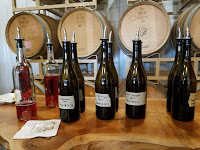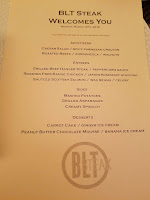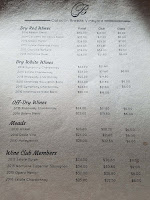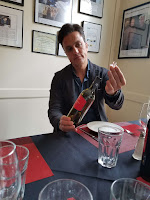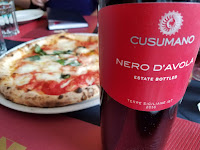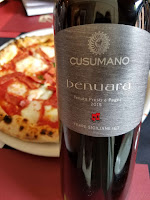 We returned to Catoctin Breeze Vineyard last weekend shortly after our ski visit in order to attend a club barrel tasting event. The session was led by winemaker Mike Lentini who had pulled barrel samples of four future releases. The first was an upcoming rosé made from gently pressed Chambourcin grapes grown by a grower in Maryland's St. Mary's County. This vineyard benefits from sandy soils and marine coastal influences and is in an area that Dr. Joe Fiola (Extension Specialist in Viticulture and Small Fruit for the University of Maryland) has championed for years. This Chambourcin rosé is already delicious and showcases the versatility of the fruit. It is light and fresh with plenty of acids and is no comparison to the Syrah rosé wine currently on display. Expect an early summer release.
We returned to Catoctin Breeze Vineyard last weekend shortly after our ski visit in order to attend a club barrel tasting event. The session was led by winemaker Mike Lentini who had pulled barrel samples of four future releases. The first was an upcoming rosé made from gently pressed Chambourcin grapes grown by a grower in Maryland's St. Mary's County. This vineyard benefits from sandy soils and marine coastal influences and is in an area that Dr. Joe Fiola (Extension Specialist in Viticulture and Small Fruit for the University of Maryland) has championed for years. This Chambourcin rosé is already delicious and showcases the versatility of the fruit. It is light and fresh with plenty of acids and is no comparison to the Syrah rosé wine currently on display. Expect an early summer release. The tasting then turned to three reds starting with a Petit Verdot, sourced from the same St. Mary's vineyard. This will be a big wine, huge, with hoards of jammy dark fruit, abundant tannins, and juicy acidity. The current condition of the wine reflects the grape's thick skins and natural acidity and will benefit tremendously with additional barrel aging and bottle conditioning. Expect an early winter 2018-2019 release. A future estate grown Cabernet Franc is in a similar condition. It is big and raw with plenty of flavor and inherent pepper characters. Mike believes that Cab Franc is the future for Maryland red wine (I saw a similar pattern with their southerly neighbor) and the winery intends to capitalize on their productive estate vineyard. Expect the same release schedule as the Petit Verdot. The final red was the future vintage of Concerto, their signature Bordeaux blend -- which in this release will be majority Cabernet Franc, followed by Cabernet Sauvignon, Merlot, and Petit Verdot. This wine is ready now, even out white wine preferring friends easily quaffed this delicious blend. Expect, I believe, a fall 2018 release.
The tasting then turned to three reds starting with a Petit Verdot, sourced from the same St. Mary's vineyard. This will be a big wine, huge, with hoards of jammy dark fruit, abundant tannins, and juicy acidity. The current condition of the wine reflects the grape's thick skins and natural acidity and will benefit tremendously with additional barrel aging and bottle conditioning. Expect an early winter 2018-2019 release. A future estate grown Cabernet Franc is in a similar condition. It is big and raw with plenty of flavor and inherent pepper characters. Mike believes that Cab Franc is the future for Maryland red wine (I saw a similar pattern with their southerly neighbor) and the winery intends to capitalize on their productive estate vineyard. Expect the same release schedule as the Petit Verdot. The final red was the future vintage of Concerto, their signature Bordeaux blend -- which in this release will be majority Cabernet Franc, followed by Cabernet Sauvignon, Merlot, and Petit Verdot. This wine is ready now, even out white wine preferring friends easily quaffed this delicious blend. Expect, I believe, a fall 2018 release. By chance during a tour of the events area, Mike happened to spot a floater in a bottle of Sauvignon Blanc that was being stored for a spring-summer release. This is another wine that I preferred more than the current release available in the tasting room. It is fresh, citrus - but not lemongrass - with a nice saline character. Perhaps another sourced from St. Marys?
By chance during a tour of the events area, Mike happened to spot a floater in a bottle of Sauvignon Blanc that was being stored for a spring-summer release. This is another wine that I preferred more than the current release available in the tasting room. It is fresh, citrus - but not lemongrass - with a nice saline character. Perhaps another sourced from St. Marys? After a round of sampling through their Sweet ($8) and Signature ($10) wine tastings I wanted to comment on the meads. The have three honey wines available, all from a large 2010 vintage and each has a touch of sweetness without any clawing sugary aftertaste. The Honeymmon ($25) is blended with orange juice and feels like fall whereas the Amber ($23) is spiced with Christmas flavors. Both are solid meads. However we came home with a bottle of the Dolce Vita ($24), a melomel mead made with blackberries. The berry flavors are prevalent with the sweet honey kicking in near the tail. Nicely done.
After a round of sampling through their Sweet ($8) and Signature ($10) wine tastings I wanted to comment on the meads. The have three honey wines available, all from a large 2010 vintage and each has a touch of sweetness without any clawing sugary aftertaste. The Honeymmon ($25) is blended with orange juice and feels like fall whereas the Amber ($23) is spiced with Christmas flavors. Both are solid meads. However we came home with a bottle of the Dolce Vita ($24), a melomel mead made with blackberries. The berry flavors are prevalent with the sweet honey kicking in near the tail. Nicely done. When leaving we decided to also tour the three covered bridges in Frederick County all within 10 miles of the winery. In fact, the closest, Loy's Station, is only a half mile past the winery on Roddy Road. These are impressive structures which even Civil War soldiers respected while marching through the area. After theCompass Craft Beverage Finder navigates you to Orchard Cellars continue to these bridges. Cheers.
